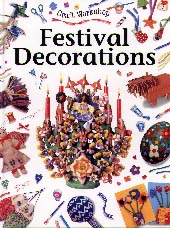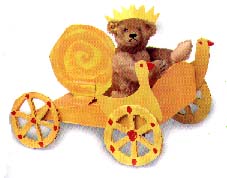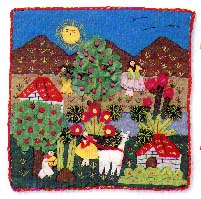|
________________
CM . . . .
Volume V Number 10 . . . . January 15, 1999
These new titles in the "Craft Workshop Series" were first published in England.
Fabric is similar to the other volumes in the series in that it provides
beautiful photographs of objects like Kirghiz felt rugs, West African
tie-dying, Yoruba cotton and Peruvian arpilleras. The instructions are
slightly better in this volume, but there are still problems. To make a
"proggy rug" children are told to buy a "progger" or punch at a craft store and
have an adult attach a "sacking" to a frame. The "progging" technique requires
much skill and a great deal of time. The projects are also quite complex and
require a lot of adult help and expensive supplies. For example, silk and gutta
are used for silk painting. The author does not explain the special tool for
the gutta. Canadian children will be frustrated by the ideas presented as they
would not be able to do the projects on their own or easily find the supplies.
Models has more spectacular photos, this time of Hopi Kachina dolls,
African galimotos, action folk wooden models and other unusual models from
around the world. There are instructions for making projects such as a
Japanese "good-luck" cat of papier mache. The inside form is made of clay, and
it is not easy for children to have access to this material at home. An easier
substitute would be plasticine. The best section in this book is the one on
fierce creatures made from salt dough and self hardening clay. Children will
love the wild samples shown here.
Paper has information on the history of paper and its uses throughout
time. The description of Japanese paper making is incorrect. It mentions that
the pulp was made, and "when the pulp dried, it turned into paper." An
important step is missing - the use of a mold to create the sheets. The text
also states that the printing press was invented in 1450 which is incorrect and
a simplification of the history of the printed book. The crafts with paper
include paper cutting, marbling, pulp models, and papier mache. On page 13, the
authors show "paste paper with flour and paint" and on page 15 the craft is
called "Dragged designs" with cornstarch and paint. Why the confusion? Why not
explain that the recipe can be made with flour? Why not clearly describe what
kinds of paints can be added to the recipe? In the instructions for marbling,
children are told to put the marbled sheets on to newspapers to dry. But a
better technique is to hang them to dry or to leave them on plastic as the wet
paper will stick to newspaper.
Children and adults will be frustrated in trying to do these projects with the
skimpy and sloppy instructions. The "Kids Can Do It" series from Kids Can
Publishing is a much better series with accessible instructions and reasonably
priced supplies.
Not recommended.
Lorraine Douglas is the Administrative Coordinator of Youth Services at
the Winnipeg Public Library in Winnipeg, Manitoba.
To comment on this title or this review, send mail to cm@umanitoba.ca.
Copyright © the Manitoba Library Association.
Reproduction for personal use is permitted only if this copyright notice
is maintained. Any other reproduction is prohibited without
permission.
Published by
TABLE OF CONTENTS FOR THIS ISSUE - JANUARY 15, 1999.
AUTHORS |
TITLES |
MEDIA REVIEWS |
PROFILES |
BACK ISSUES |
SEARCH |
CMARCHIVE |
HOME
|



 In Festival Decorations, the emphasis is on describing numerous world
festivals such as Diwali, Easter, and family festivals and the objects which
are associated with each of these traditions. Very attractive colour
photographs reveal papier mache eggs, mom and dad cards, and cloth angels.
There are captions beside these photos which provide inadequate instructions
for young children to make the crafts. The last section of the book has "Life
and Death" festivals including the Mexican Day of the Dead. Children are
invited to make a "Fantastic lion coffin" and a "Sugar Skull." The instructions
for the skull are: "Mold ready-made fondant icing, which you can buy in a cake
decorating store into a skull. Shape a jaw and push in eyes. Decorate the skull
with cake decorations and candies." These instructions reveal the British
origins of the text and would be incomprehensible to Canadian children.
In Festival Decorations, the emphasis is on describing numerous world
festivals such as Diwali, Easter, and family festivals and the objects which
are associated with each of these traditions. Very attractive colour
photographs reveal papier mache eggs, mom and dad cards, and cloth angels.
There are captions beside these photos which provide inadequate instructions
for young children to make the crafts. The last section of the book has "Life
and Death" festivals including the Mexican Day of the Dead. Children are
invited to make a "Fantastic lion coffin" and a "Sugar Skull." The instructions
for the skull are: "Mold ready-made fondant icing, which you can buy in a cake
decorating store into a skull. Shape a jaw and push in eyes. Decorate the skull
with cake decorations and candies." These instructions reveal the British
origins of the text and would be incomprehensible to Canadian children.
